Awhile back, I was at a local range to shoot an old Mauser military rifle. Since it was a weekday morning, nobody else was around. Perfect. No paper targets were put up because the high dirt berm into which the bullets impacted, was peppered with small, light-colored rocks. These were just large enough to appear clearly above the pyramid-shaped military front sight at 200-plus yards. Shooting prone with a sling offered excellent practice. Let the fun begin!
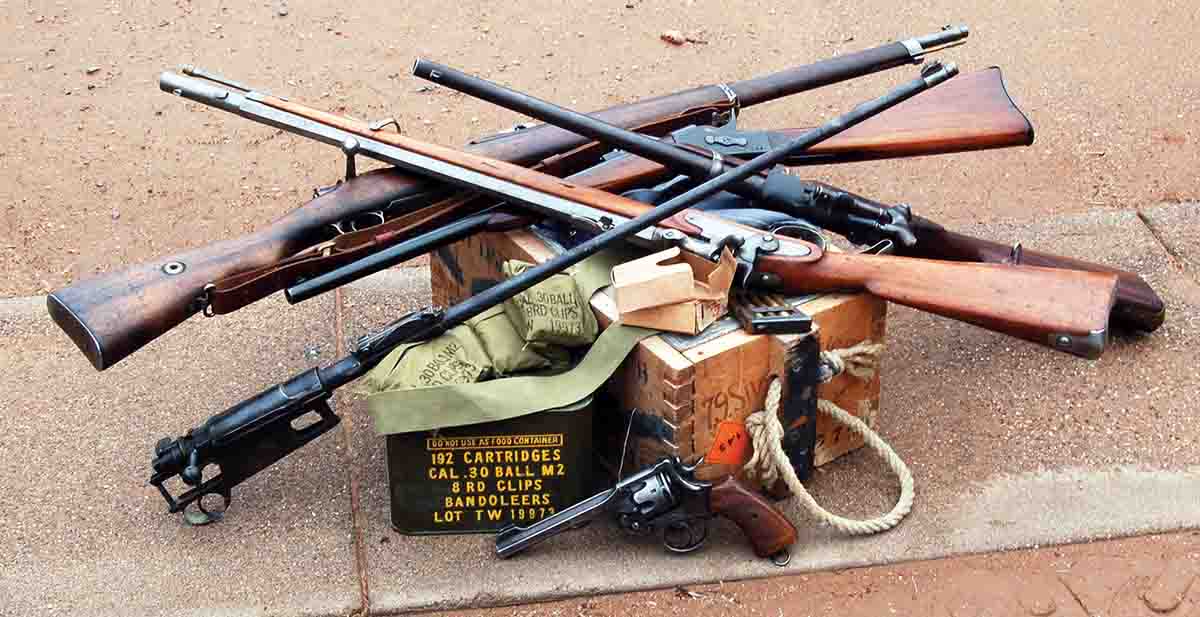
The 8x52Rmm (Type 66) Siamese is a child of the “Great Age of Surplus,” when all manner of weird arms were available by mail.
Sometime later, another shooter drove up and seeing no target frames, he came over to investigate. The young fellow was fascinated by the Mauser, and admitted he was new to shooting and had never seen a bolt-action rifle that did not have a scope attached. When I suggested he fire several rounds at my white rocks, he said he wouldn’t feel right shooting up all that expensive ammunition. Replying that I could stand the nickel a round cost, my new friend was silent for a moment, then stammered that he had paid four times that per round in tax for the cartridges he was going to shoot that day. I suddenly realized that the era of unrestricted cheap surplus guns and ammunition, which seemed so recent to me, was over long before this chap was born. I was a 1950s-era shooter firing a World War I-era rifle with World War II-era ammunition at Mesozoic-era rocks! I felt a need to sit down and rest.
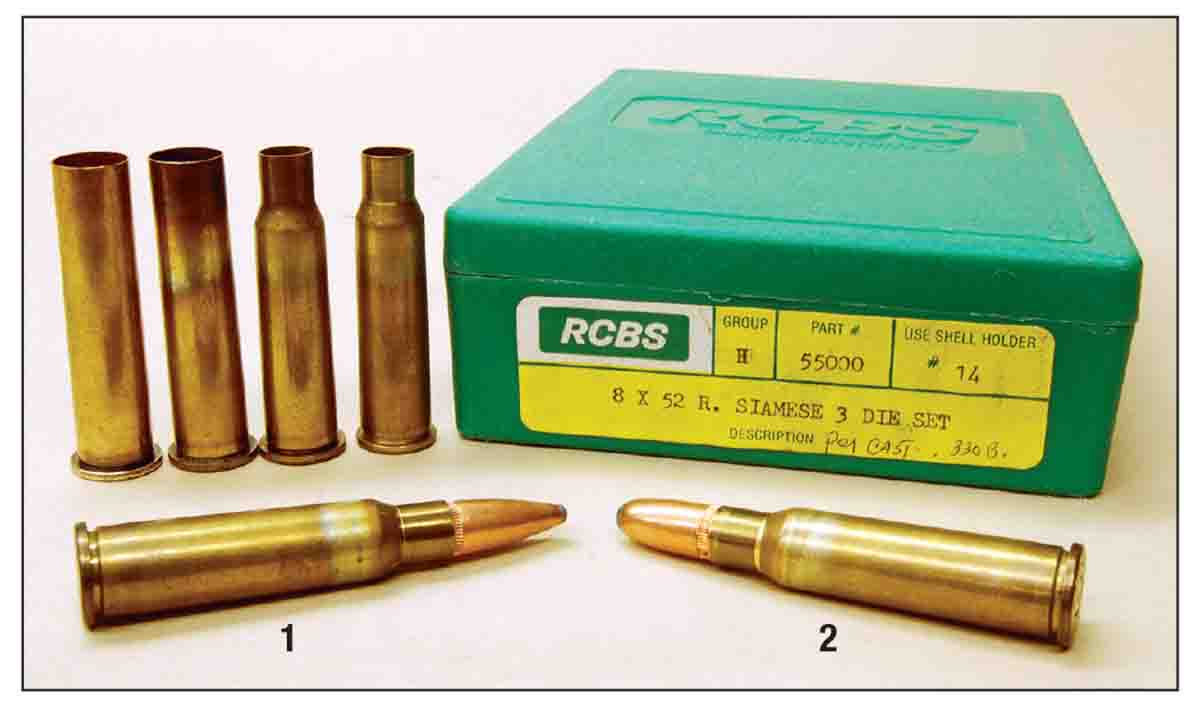
Special order RCBS dies easily form 8x52Rmm (Type 66) cases from .45-70 brass (as shown at left). Loaded rounds use a (1) Remington 185-grain Core-Lokt bullet and a (2) Hornady 170-grain roundnose. Both are .323-inch diameter.
This is mentioned because the 8x52Rmm (Type 66) Siamese and its rifle represent perhaps the last of the unregulated, inexpensive smokeless powder surplus military rifles available as the Gun Control Act of 1968 began to shut off such imports. It was the beginning of the end of serious riflefolk being able to buy all types of military rifles, delivered directly in the U.S. mail and shoot them almost as much as they wanted while still being able to afford to eat occasionally.
The chronicles tell us the Kingdom of Siam was in existence for a very long time, something on the order of a thousand years. Absolute monarchy ended in the 1930s. The country is now known as Thailand. Any government lasting that long must have known a great deal about military armaments given that history has never had a shortage of little men with big egos intent on enslaving or killing their neighbors.
Siam’s first cartridge rifle was the Mauser Model 71, purchased shortly after 1876 when Mauser started accepting foreign orders. The cartridge was the 11x60Rmm or simply, 11mm Mauser. Holding nearly 80 grains of black powder behind a 320-grain, paper-patched lead bullet, it was typical of military rounds of the time.
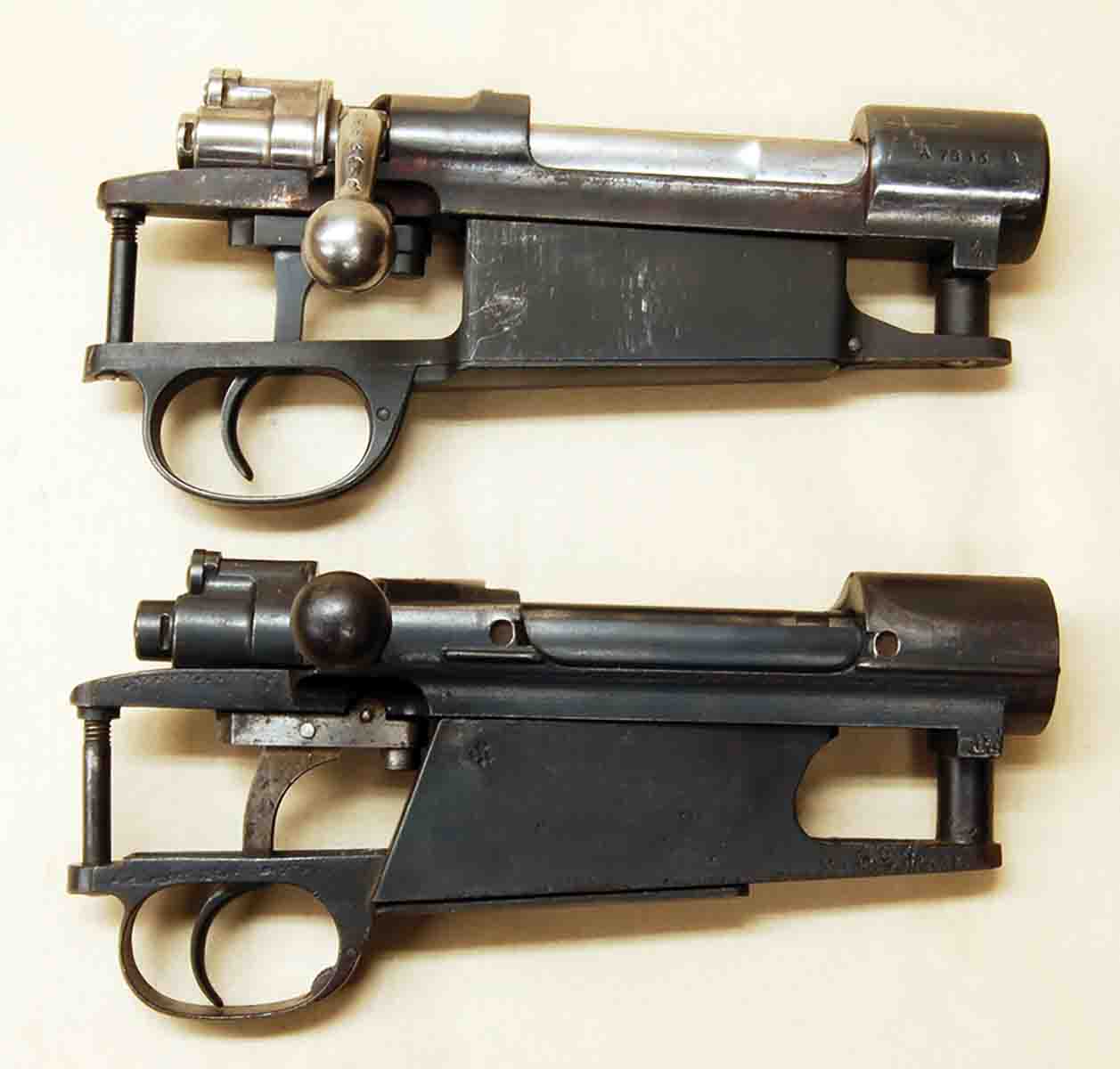
The 1909 Argentine Mauser 98 action (top) has a conventional magazine box, while the Siamese Mauser (bottom) uses an odd-looking “slant-box” magazine necessary for its rimmed cartridges.
In 1902, Siam modernized with a new rifle and a cartridge it called the 8x50Rmm (Type 45). The last part of the name is derived from the Siamese equivalent of 1902, which is 2445. The new rifle was simply a standard Mauser 98 action, stock and barrel. Considered unique, however, was a rearward slanted magazine box, deemed necessary to position the rounds so the rim of the top cartridge wouldn’t catch on the rim of the one below it when feeding into the chamber. The new cartridge was also declared unique by several sources. Both ideas, however, had been seen before.
In 1898, Mauser signed a contract giving John Rigby & Co. exclusive rights to import Mauser rifles, actions and barreled actions into Britain and its colonies. In 1899, Rigby asked Mauser to make a Model 98 for Rigby’s long .400/.350 rimmed round. Thus, the Magnum Mauser was born, but it used a rearward slanted magazine box because of the rimmed cartridge. Whether this idea originated with Mauser or Rigby is not recorded.
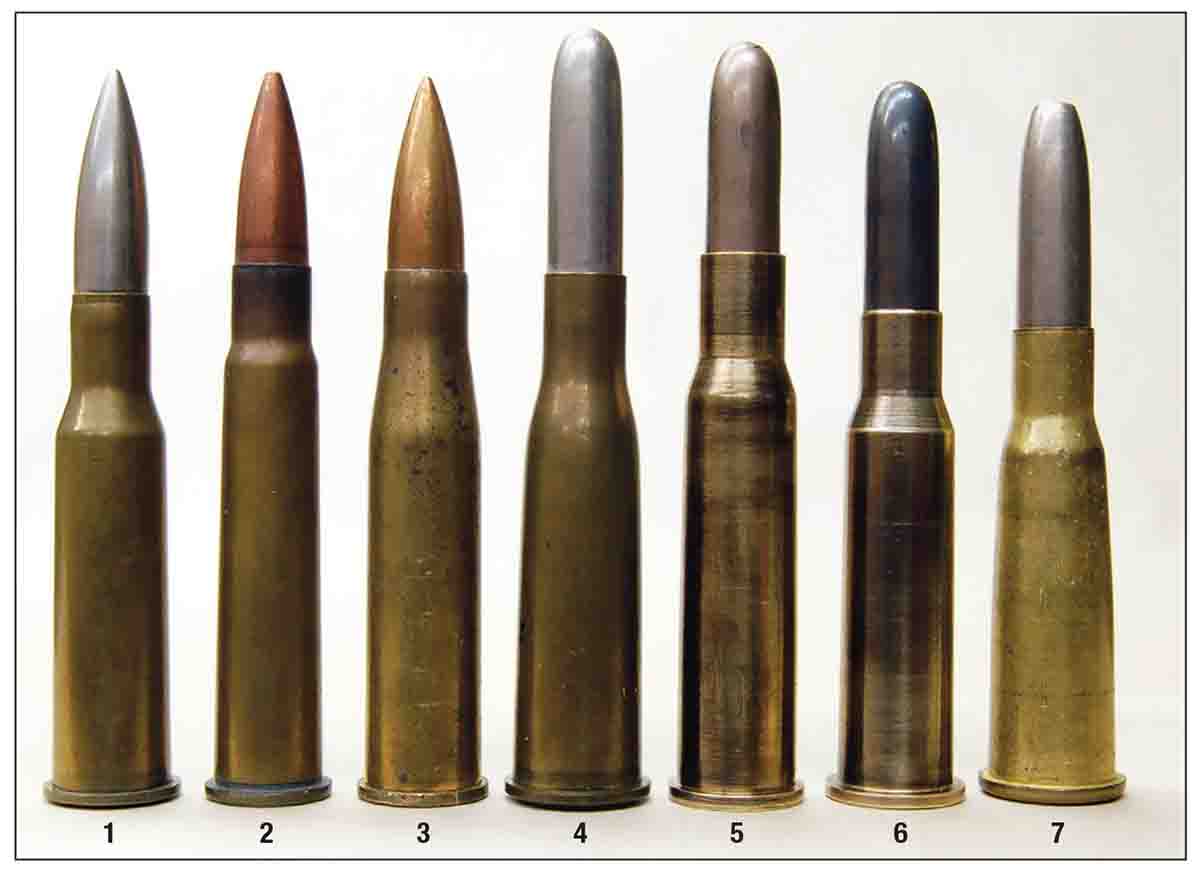
Rimmed military rounds contemporary with the Siamese include: (1) 7.62x54R Russian, (2) .303 British, (3) 8mm Hungarian Mannlicher, (4) 8mm Kropatschek, (5) 8x58R Danish Krag, (6) 8x50R Mannlicher, which is identical to the 8x50Rmm (Type 45) Siamese and (7) 8mm Lebel. Not much originality here.
In that same year, Rigby also asked Mauser to make a smaller and lighter action for the British .303 round. That cartridge is rimmed so this action also used a slanted magazine box. Thus, the “unique” magazine was already in use when Mauser made a few rifles in 8x50Rmm (Type 45) for Siamese trials.
Mauser was also familiar with the “new” 8x50Rmm Siamese round, but rather knew it as the 8x50Rmm Austrian Mannlicher. This cartridge was developed by Georg Roth Co. in 1888. It fired a 249-grain steel jacket roundnose bullet ahead of 62 grains of compressed black powder. The velocity was listed at 1,750 feet per second (fps). Smokeless powder came along in 1890 and was improved in 1893 to give 2,035 fps from a 30-inch barrel. The Siamese loading was listed as a 241-grain roundnose at about 2,050 fps from a 30-barrel. Nothing mysterious here. That comes next.
After acceptance as the Siamese Model 1902 (Type 45) rifle and cartridge, manufacturing was contracted not to Mauser, but the government arsenal at Tokyo, Japan. Presumedly, there was a licensing agreement with Mauser. Then, to add to the strange situation, between 1904 and 1914, Siam purchased an undetermined number of standard export M98 military rifles chambered in 7x57mm. The purpose of these rifles is unknown, as is what happened to them.
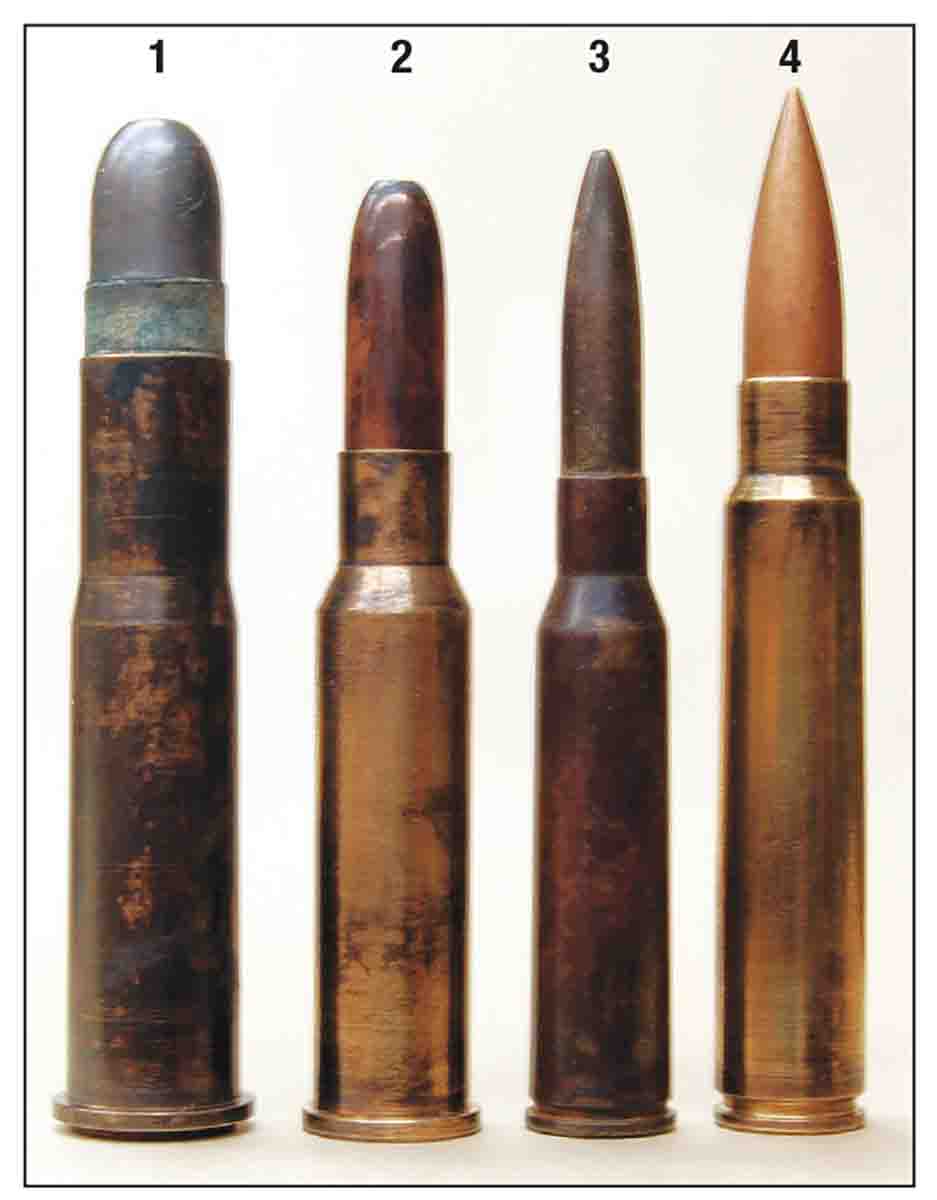
Japanese military rounds in order of usage include: (1) 11x60R Murata, which is a copy of the 11mm Mauser, (2) 8mm Murata that is almost identical to the 8x52Rmm (Type 66) Siamese, (3) 6.5mm Arisaka and the (4) 7.7x58mm Arisaka. Japan made 8mm Siamese rifles and loaded the ammunition for them for many years.
Then, in 1923, the Siamese adopted a new (really, just modified) rifle and cartridge, both called the Model 1923 (Type 66). This rifle was nothing more than the Model 1902 (Type 45) with the barrel shortened to 22 inches and chambered for the “new” cartridge. Gone was the old roundnose slug, replaced by a 179-grain spitzer driven to a reported 2,200-2,500 fps. All that was done to create it was to lengthen the case of the 8x50Rmm (Type 45) 2 millimeters and sharpen the shoulder a few degrees – just enough so that it wouldn’t chamber in the older rifles. In fact, it’s just an 8mm Japanese Murata of 1887. Talk about strange! The reason for this escapes everyone.
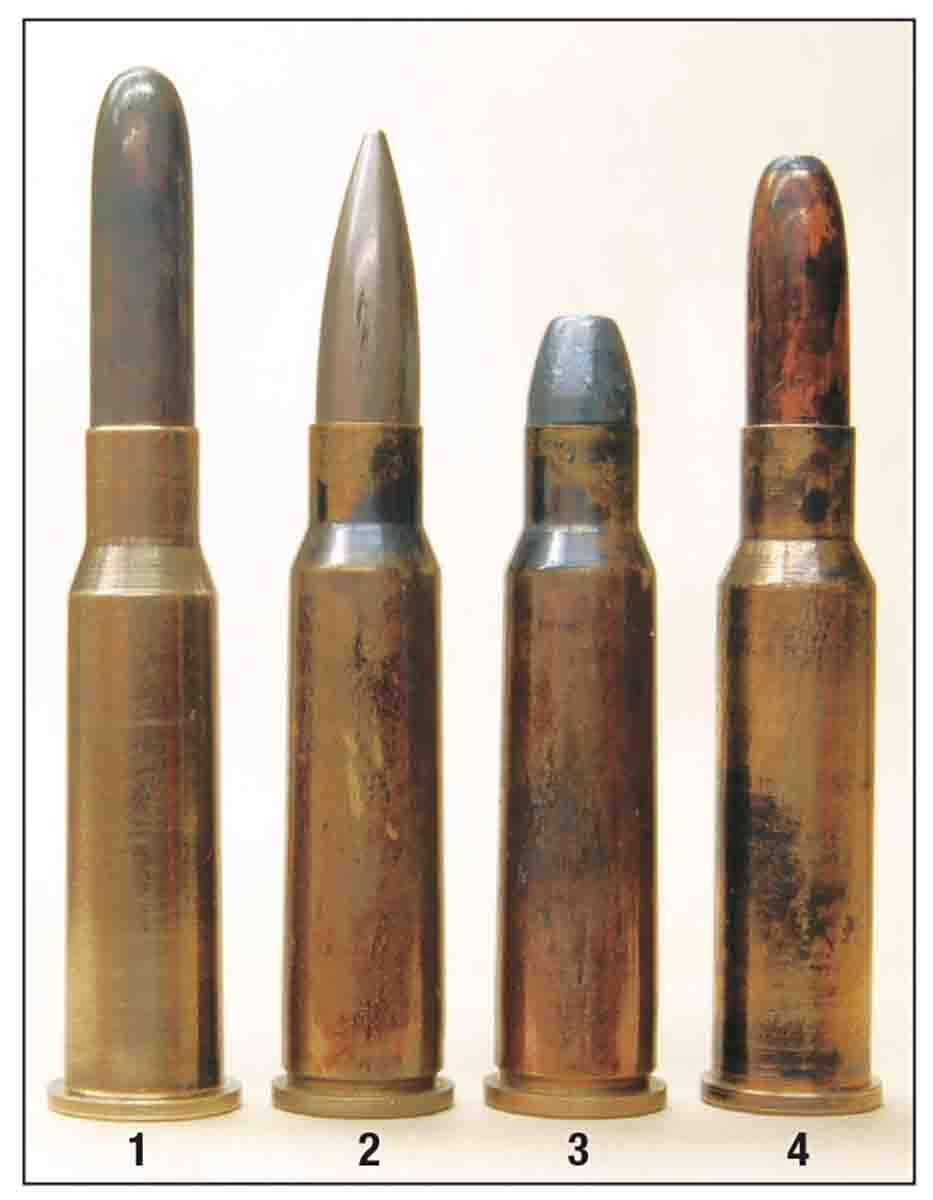
Rounds incude: (1) 8x50Rmm (Type 45) Siamese, (2) 8x52Rmm (Type 66) Siamese, (3) 8x52Rmm (Type 66) Short Range and (4) 8mm Japanese Murata.
Rechambering of Type 45 rifles was then begun with some also being cut down to Type 66 specifications. However, not all were converted. When imported into the U.S., many
were still chambered for the 8x50Rmm (Type 45). Identification is easy because modified rifles will have the elevation ramp of the rear sight, milled down to match the flatter trajectory of the spitzer bullet, as shown in the photos. Rifles rechambered for 8x52Rmm (Type 66) having excellent bores are not hard to find. One definitely belongs in any military Mauser collection and are fun to shoot as well.
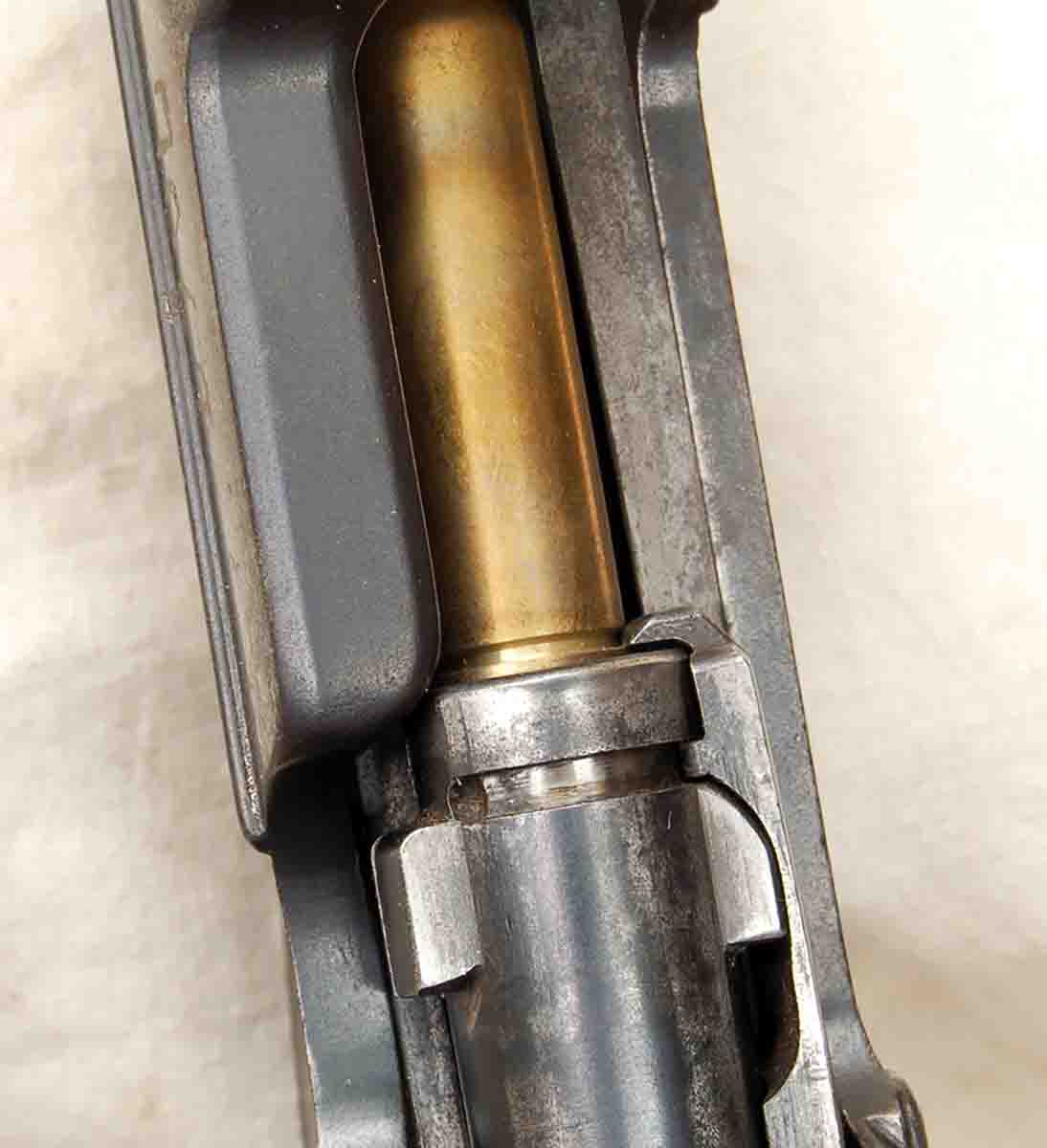
The rim of the Siamese round slips behind the extractor as it comes out of the magazine – just like rimless cases do.
Ammunition for the 8x52Rmm (Type 66) was loaded in Japan and Thailand. Kynoch loaded it under military contract in 1932 and 1950. One reference listed Norma, but that could not be verified.
Unfortunately, at this late date, the only source of ammunition is either someone who loads custom ammunition or personal handloading. Reloading dies were once listed as “special order.” Mine are RCBS. Today, I’m certain Redding could supply them if not too busy with standard orders. Then there is always the internet.
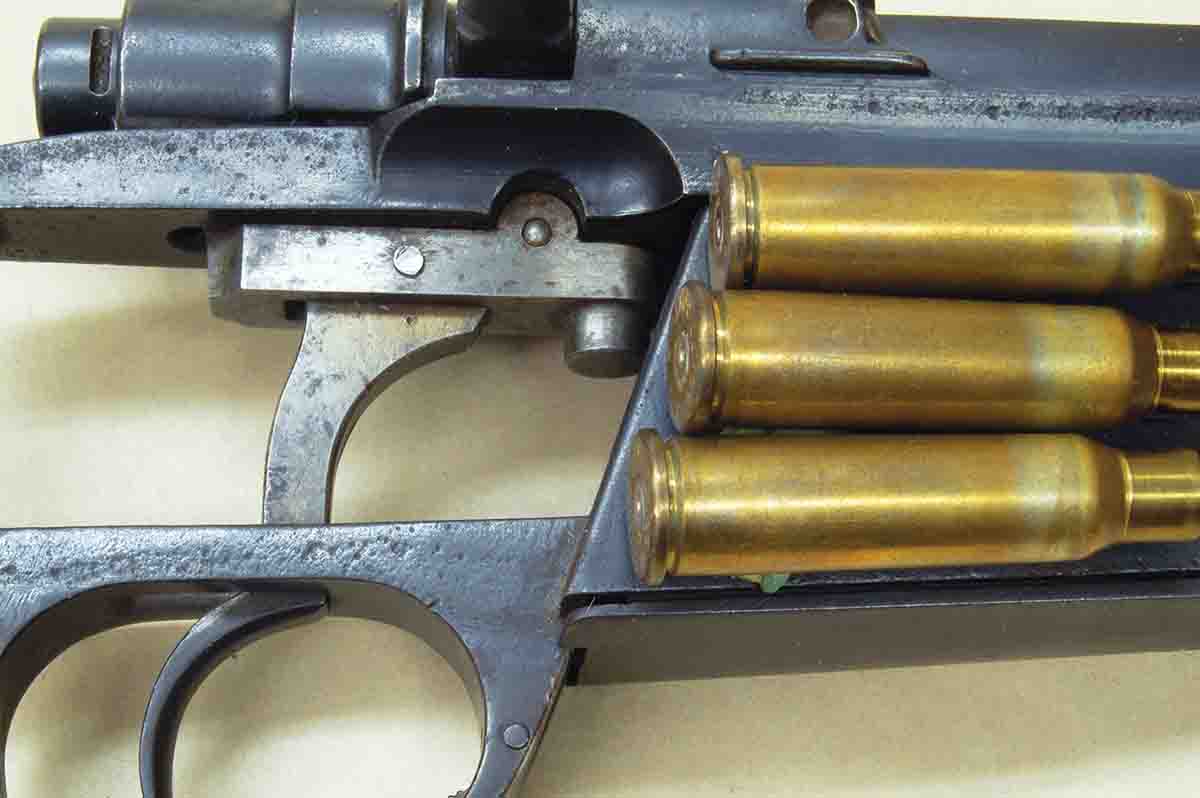
The slanted magazine of the Siamese Mauser positions the rim on top of the cartridge ahead of the rim of the lower one. This prevents jams as the top round feeds out of the magazine.
I once owned both a barreled action and complete rifle in 8x52R (Type 66) with perfect bores. No original 8x50R (Type 45) has been seen with a shootable bore, which may explain why they weren’t rechambered. Groove diameters were .329 inch; bores were .314 inch. Thus, groove depth was .0075 inch, or nearly twice the normal .004 inch. Strange. Normal 8mm bullets are .323-inch diameter, yet accuracy with these bullets is no different than other military rifles of the time. Of course, this is with issue open sights. Strange.
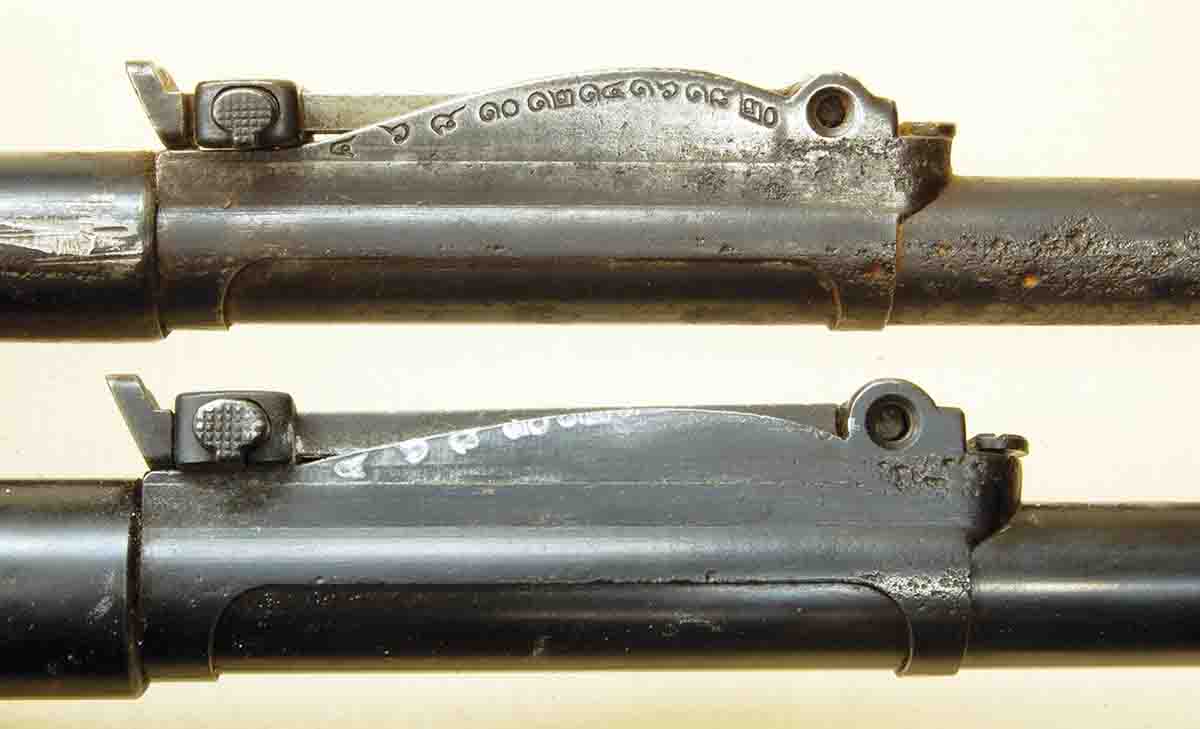
The original rear sight of the 8x50Rmm (Type 45) rifle (top). The milled down elevator ramp of the 8x52Rmm (Type 66) rifle (bottom) allows for its flatter trajectory.
The reasons for the infinitesimal changes that created the 8x52Rmm (Type 66) are unknown. Regarding muzzle energy, we just have a modern-day .30-30 Winchester. Neverthe-less, with a little work, we can own and shoot the last example of unrestricted surplus arms purchased in America.
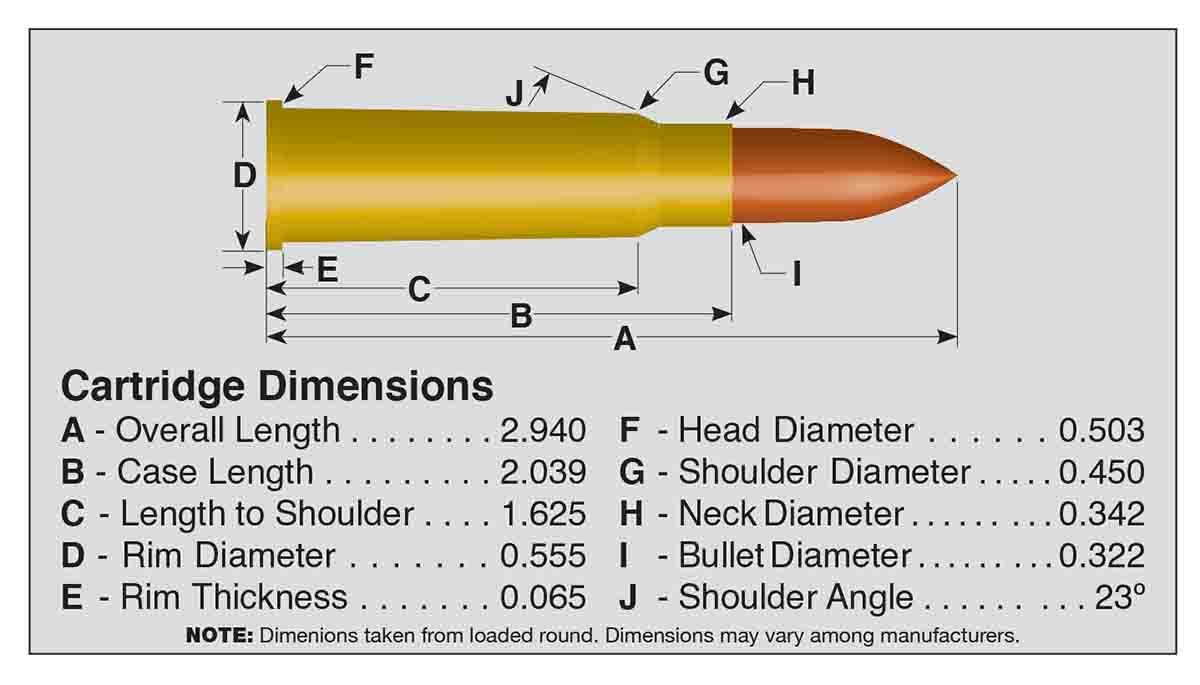









.jpg)


